
Concept explainers
(a)
Interpretation:
The correct structure is to be drawn from the given IUPAC name of the molecule.
Concept introduction:
The structure of a compound can be drawn on the basis of its IUPAC name. The IUPAC name is made of three parts, prefix, root, and suffix. The suffix indicates the highest priority group present. Its location is written as a prefix for the functional group name unless redundant. The root is the longest continuous carbon chain that also includes the highest priority functional group. Any other
If any chiral carbons are present, their absolute configurations are specified at the start along with the carbon number if necessary. Similarly, the stereochemistry (E/Z) of any double bond is also specified at the start. A prefix di, tri, etc., before a prefix or suffix indicates the number of instances of that functional group.
Answer to Problem F.6P
The correct structure of
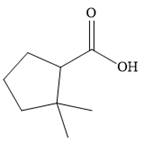
Explanation of Solution
The compound is a
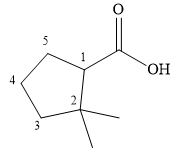
The methyl groups are then attached to the next ring carbon.
Therefore, the structure of

The structure of the compound can be drawn from its IUPAC name, which lists the functional groups attached to an alkyl/aryl root (parent).
(b)
Interpretation:
The correct structure is to be drawn from the given IUPAC name of molecule.
Concept introduction:
The structure of a compound can be drawn on the basis of its IUPAC name. The IUPAC name is made of three parts, prefix, root, and suffix. The suffix indicates the highest priority group present. Its location is written as a prefix for the functional group name unless redundant. The root is the longest continuous carbon chain that also includes the highest priority functional group. Any other functional groups present are listed alphabetically as prefixes along with their locants.
If any chiral carbons are present, their absolute configurations are specified at the start along with the carbon number if necessary. Similarly, the stereochemistry (E/Z) of any double bond is also specified at the start. A prefix di, tri, etc., before a prefix or suffix indicates the number of instances of that functional group.
Answer to Problem F.6P
The structure of
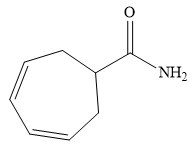
Explanation of Solution
The name shows that the root is a seven carbon ring with two double bonds. The root name is, therefore, cycloheptadiene. The only functional group is an amide (
Thus, the structure of

The structure of the compound can be drawn from its IUPAC name, which lists the functional groups attached to an alkyl/aryl root (parent).
(c)
Interpretation:
The correct structure of
Concept introduction:
The structure of a compound can be drawn on the basis of its IUPAC name. The IUPAC name is made of three parts, prefix, root, and suffix. The suffix indicates the highest priority group present. Its location is written as a prefix for the functional group name unless redundant. The root is the longest continuous carbon chain that also includes the highest priority functional group. Any other functional groups present are listed alphabetically as prefixes along with their locants.
If any chiral carbons are present, their absolute configurations are specified at the start along with the carbon number if necessary. Similarly, the stereochemistry (E/Z) of any double bond is also specified at the start. A prefix di, tri, etc., before a prefix or suffix indicates the number of instances of that functional group.
Answer to Problem F.6P
The structure of
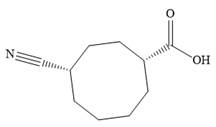
Explanation of Solution
The name shows that the root is an eight carbon ring with two functional groups directly attached to ring carbons. The highest priority group is a carboxylic acid group, and the corresponding ring carbon is numbered 1. The second, nitrile group, is then on C4.
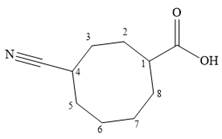
Both C1 and C4 are chiral carbons with R and S configurations respectively. According to Cahn-Ingold-Prelog rules, this means the priority groups 1 to 3 attached to C1 are arranged clockwise if the lowest priority group H is pointing away from the observer, or counterclockwise if H is pointing toward the observer. The priority groups 1 to 3 attached to C4 are arranged conterclockwise if the lowest priority H is pointing away, or clockwise if it is pointing toward the observer.
The structure of the compound can, therefore, be drawn as:
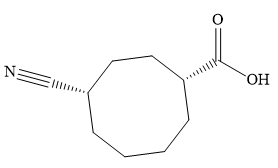
The structure of the compound can be drawn from its IUPAC name, which lists the functional groups attached to an alkyl/aryl root (parent).
(d)
Interpretation:
The structure of
Concept introduction:
The structure of a compound can be drawn on the basis of its IUPAC name. The IUPAC name is made of three parts, prefix, root, and suffix. The suffix indicates the highest priority group present. Its location is written as a prefix for the functional group name unless redundant. The root is the longest continuous carbon chain that also includes the highest priority functional group. Any other functional groups present are listed alphabetically as prefixes along with their locants.
If any chiral carbons are present, their absolute configurations are specified at the start along with the carbon number if necessary. Similarly, the stereochemistry (E/Z) of any double bond is also specified at the start. A prefix di, tri, etc., before a prefix or suffix indicates the number of instances of that functional group.
Answer to Problem F.6P
The correct structure of
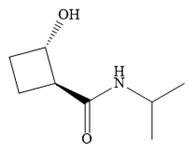
Explanation of Solution
The name shows that the root is a cyclobutane ring. Two functional groups are attached to the ring, a secondary amide and a hydroxyl group. The amide is the higher priority group, so the ring atoms are numbered from the carbon to which it is attached. The hydroxyl group is then attached to the adjacent carbon C2.
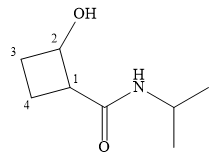
C1 and C2 are both chiral carbons with an absolute configuration of S. This means on each of these carbons, the priority 1 to 3 groups are arranged counterclockwise with the lowest priority H pointing away from the observer, or clockwise with the H pointing toward the observer.
The complete structure, using dash-wedge representation, for the two functional groups, can then be drawn as

The structure of the compound can be drawn from its IUPAC name, which lists the functional groups attached to an alkyl/aryl root (parent).
(e)
Interpretation:
The structure of
Concept introduction:
The structure of a compound can be drawn on the basis of its IUPAC name. The IUPAC name is made of three parts, prefix, root, and suffix. The suffix indicates the highest priority group present. Its location is written as a prefix for the functional group name unless redundant. The root is the longest continuous carbon chain that also includes the highest priority functional group. Any other functional groups present are listed alphabetically as prefixes along with their locants.
If any chiral carbons are present, their absolute configurations are specified at the start along with the carbon number if necessary. Similarly, the stereochemistry (E/Z) of any double bond is also specified at the start. A prefix di, tri, etc., before a prefix or suffix indicates the number of instances of that functional group.
Answer to Problem F.6P
The structure of
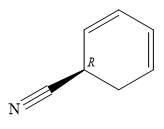
Explanation of Solution
The name shows that the root is a six carbon ring, with two double bonds. The root name is, therefore, cyclohexadiene. One functional group, nitrile, is attached to the ring. The ring
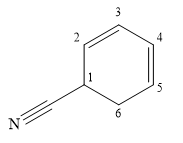
C1 is a chiral carbon with an absolute configuration of R. Therefore, the priority groups 1 to 3 attached to it must be arranged clockwise with the lowest priority hydrogen pointing away from the observer.
Thus, the structure of the compound can be drawn as
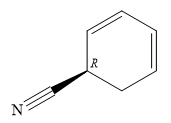
The structure of the compound can be drawn from its IUPAC name, which lists the functional groups attached to an alkyl/aryl root (parent).
Want to see more full solutions like this?
Chapter F Solutions
Organic Chemistry: Principles and Mechanisms (Second Edition)
- Write the electron configuration of an atom of the element highlighted in this outline of the Periodic Table: 1 23 4 569 7 He Ne Ar Kr Xe Rn Hint: you do not need to know the name or symbol of the highlighted element! §arrow_forwardIdentify the amino acids by name. Illustrate a titration curve for this tetrapeptide indicating the pKa's for each ionizable groups and identify the pI for this tetrapeptide. please helparrow_forward↓ ina xSign x Sign X labs X Intro X Cop Xa chat X My Cx Grac X Laur x Laur xash learning.com/ihub/assessment/f188d950-dd73-11e0-9572-0800200c9a66/d591b3f2-d5f7-4983-843c-0d00c1c0340b/f2b47861-07c4-4d1b-a1ee-e7db2 +949 pts /3400 K Question 16 of 34 > © Macmillan Learning Draw the major E2 reaction product formed when cis-1-chloro-2-ethylcyclohexane (shown) reacts with hydroxide ion in DMSO. H CH2CH3 H H HO- H H H Cl DMSO H H C Select Draw Templates More C H 0 2 Erasearrow_forward
- A common buffer for stabilizing antibodies is 100 mM Histidine at pH 7.0. Describe the preparation of this buffer beginning with L-Histidine monohydrochloride monohydrate and 1 M NaOH. Be certain to show the buffering reaction that includes the conjugate acid and base.arrow_forwardFina x | Sign X Sign X lab: X Intro X Cop) X a chat x My x Grad xLaur x Laur x a sheg X S Shoj XS SHE X acmillanlearning.com/ihub/assessment/f188d950-dd73-11e0-9572-0800200c9a66/d591b3f2-d5f7-4983-843c-0d00c1c0340b/f2b47861-07c4-4d1b-a1ee-e7db27d6b4ee?actualCourseld=d591b3f2- 5 © Macmillan Learning Organic Chemistry Maxwell presented by Macmillan Learning For the dehydrohalogenation (E2) reaction shown, draw the Zaitsev product, showing the stereochemistry clearly. H H KOH Br EtOH Heat Select Draw Templates More Erase // C H Q Search hp Q2 Q Δ קו Resouarrow_forwardIs the structural form shown possible given the pKa constraints of the side chains?arrow_forward
- on x Fina X Sign X Sign x lab X Intro X Cop X chat X My x Grac x Laur x Laur x ashes x S Shox S SHE x a eve.macmillanlearning.com/ihub/assessment/f188d950-dd73-11e0-9572-0800200c9a66/d591b3f2-d5f7-4983-843c-0d00c1c0340b/f2b47861-07c4-4d1b-a1ee-e7db27d6b4ee?actualCourseld=d591b3f2-c stions estion. ct each urces. +95 Macmillan Learning Draw the product formed by the reaction of potassium t-butoxide with (15,25)-1-bromo-2-methyl-1-phenylbutane (shown). Clearly show the stereochemistry of the product. H BH (CH3)3CO-K+ +100 H3CW (CH3)3COH +85 H3CH2C +95 ossible ↓ Q Search Select Draw Templates More C H 0 bp A Erase 2Q 112 Resouarrow_forwardIdentify the structure of the PTH derivative generated after two rounds of Edman degradation.arrow_forwardUse the data below from an electron impact mass spectrum of a pure compound to deduce its structure. Draw your structure in the drawing window. Data selected from the NIST WebBook, https://webbook.nist.gov/chemistry/ m/z Relative intensity 31 0.5 30 26 29 22 28 100 27 33 26 23 15 4 • You do not have to consider stereochemistry. You do not have to explicitly draw H atoms. • In cases where there is more than one answer, just draw one. 妊 n ? Previous Nextarrow_forward
- for this question. Write the molecular formula for a compound with the possible elements C, H, N and O that exhibits a molecular ion at M+ = 98.1106. Exact Masses of the Most Abundant Isotope of Selected Elements Isotope Natural abundance (%) Exact mass 1H 99.985 1.008 12C 98.90 12.000 14N 99.63 14.003 160 99.76 15.995 Molecular formula (In the order CHNO, with no subscripts)arrow_forwardPLEASE READ!!! I DONT WANT EXAMPLES, I DONT WANT WORDS OR PARAGRAPHS!!! PLEASE I UNDERSTAND THE BASICS BUT THIS IS AN EXCEPTION THAT EVEN THE INTERNET CANT HELP!!!! THIS IS THE THIRD TIME I'VE SENT THOSE QUESTIONS SO PLEASE DONT RESEND THE SAME STUFF, ITS NOT HELPING ME!!! I ALSO ALREADY TRIED TO DRAW THE MECHANISM MYSELF, SO IF ITS RIGHT PLEASE TELL ME OR TELL ME WHAT I HAVE TO CHANGE!!! First image: I have to SHOW (DRAWING) the mechanism (with arows and structures of molecules) NOT WORDS PLEASE! of the reaction at the bottom. Also I have to show by mecanism why the reaction wouldn't work if the alcohol was primary Second image: I have to show the mechanism (IMAGE) (with arrows and structures of the molecules) NOT WORDS PLEASE !! for the reaction on the left, where the alcohol A is added fast in one portion HOMEWORK, NOT EXAM!! ALL DETAILS ARE IN THE IMAGES PLEASE LOOK AT THE IMAGES, DONT LOOK AT THE AI GENERATED TEXT!!!arrow_forwardWrite the molecular formula for a compound with the possible elements C, H, N and O that exhibits a molecular ion at M+ = 85.0899. Exact Masses of the Most Abundant Isotope of Selected Elements Isotope Natural abundance (%) Exact mass 1H 99.985 1.008 12C 98.90 12.000 14N 99.63 14.003 160 99.76 15.995 Molecular formula (In the order CHNO, with no subscripts)arrow_forward
 ChemistryChemistryISBN:9781305957404Author:Steven S. Zumdahl, Susan A. Zumdahl, Donald J. DeCostePublisher:Cengage Learning
ChemistryChemistryISBN:9781305957404Author:Steven S. Zumdahl, Susan A. Zumdahl, Donald J. DeCostePublisher:Cengage Learning ChemistryChemistryISBN:9781259911156Author:Raymond Chang Dr., Jason Overby ProfessorPublisher:McGraw-Hill Education
ChemistryChemistryISBN:9781259911156Author:Raymond Chang Dr., Jason Overby ProfessorPublisher:McGraw-Hill Education Principles of Instrumental AnalysisChemistryISBN:9781305577213Author:Douglas A. Skoog, F. James Holler, Stanley R. CrouchPublisher:Cengage Learning
Principles of Instrumental AnalysisChemistryISBN:9781305577213Author:Douglas A. Skoog, F. James Holler, Stanley R. CrouchPublisher:Cengage Learning Organic ChemistryChemistryISBN:9780078021558Author:Janice Gorzynski Smith Dr.Publisher:McGraw-Hill Education
Organic ChemistryChemistryISBN:9780078021558Author:Janice Gorzynski Smith Dr.Publisher:McGraw-Hill Education Chemistry: Principles and ReactionsChemistryISBN:9781305079373Author:William L. Masterton, Cecile N. HurleyPublisher:Cengage Learning
Chemistry: Principles and ReactionsChemistryISBN:9781305079373Author:William L. Masterton, Cecile N. HurleyPublisher:Cengage Learning Elementary Principles of Chemical Processes, Bind...ChemistryISBN:9781118431221Author:Richard M. Felder, Ronald W. Rousseau, Lisa G. BullardPublisher:WILEY
Elementary Principles of Chemical Processes, Bind...ChemistryISBN:9781118431221Author:Richard M. Felder, Ronald W. Rousseau, Lisa G. BullardPublisher:WILEY





